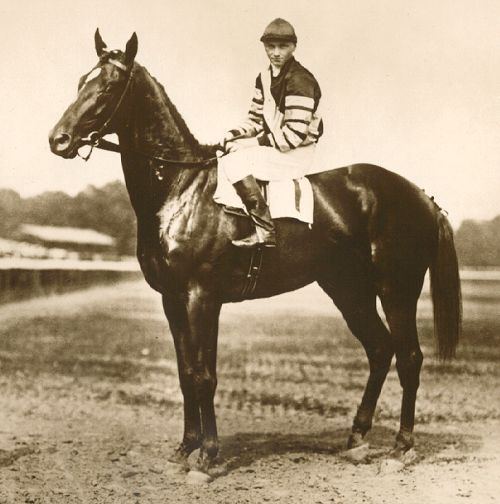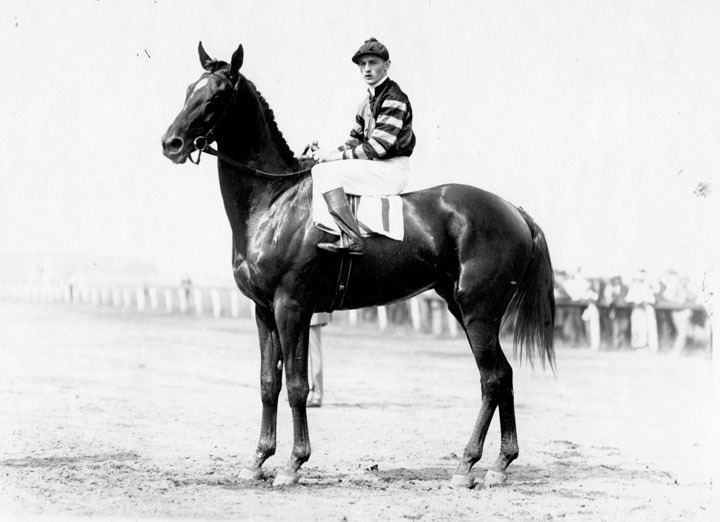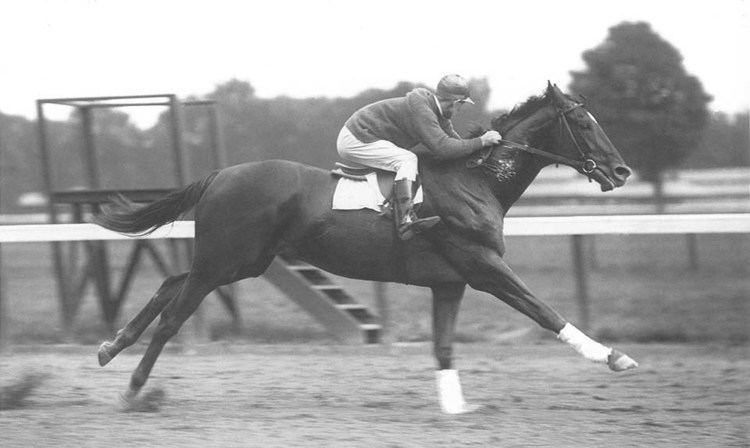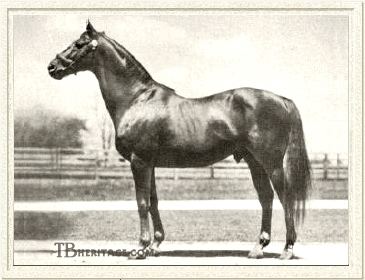Sex Stallion Height 1.68 m | Died 1 November 1947 Parents Mahubah, Fair Play | |
 | ||
Children Bateau, Hard Tack, War Admiral, War Relic, Battleship | ||
Man o war actual race footage
Man o' War, (Lexington, Kentucky, March 29, 1917 – Nursery Stud, November 1, 1947) is considered one of the greatest Thoroughbred race horses of all time. During his career just after World War I, he won 20 of 21 races and $249,465 in purses.
Contents
- Man o war actual race footage
- Man o war all videos no photos
- 1919Two year old season
- Weight carrying
- 1920 three year old season
- Stud record
- Honors
- Pedigree
- In books and film
- References

Man o' War was foaled at Nursery Stud near Lexington, Kentucky. He was sired by the prominent Fair Play. His dam, Mahubah, was sired by U.K. Triple Crown Champion Rock Sand. Man o' War was owned and bred by August Belmont, Jr. (1851–1924), whose father's accomplishments were recognized through the naming of the Belmont Stakes. Belmont Jr. joined the United States Army at age 65 to serve in France during World War I. While he was overseas, his wife named a new foal "Man o' War" in honor of her husband. However, the Belmonts decided to liquidate their racing stable. At the Saratoga yearling sale in 1918, Man o' War was sold at a final bid of $5,000 (equivalent to $80,000 in 2016) to Samuel D. Riddle, who brought him to his Glen Riddle Farm near Berlin, Maryland. The underbidder at the auction was believed to be Robert L. Gerry, Sr.

Man o war all videos no photos
1919:Two-year-old season

Trained by Louis Feustel and ridden by Johnny Loftus, Man o' War made his debut at Belmont Park on June 6, 1919, winning by six lengths. Three days later, he won the Keene Memorial Stakes, followed by another win 12 days later in the Youthful Stakes at Jamaica Racetrack. Two days, he swept to victory in the Hudson Stakes at Aqueduct to complete four wins in just 18 days. On July 5, he won the Tremont Stakes at Aqueduct, then was shipped to Saratoga where he won the United States Hotel Stakes.

In the early 1900s, there were no starting gates. Horses circled around and then lined up behind a piece of webbing known as the barrier and were sent away when it was raised. In Man o' War's only loss, the Sanford Memorial Stakes, he was still circling with his back to the starting line when the barrier was raised (though some accounts say he was turned only slightly sideways). What is undisputed is that Man o' War had a terrible start, and the normally front running colt found himself far behind the other starters. Jockey Johnny Loftus then put Man o' War in a bad position, getting boxed in by other horses. Despite this, he came close to winning, losing by a neck while conceding 15 pounds to the horse who beat him. The winner was Upset, whose name is sometimes erroneously thought to have popularized a new phrase in sports (meaning an underdog beating the favorite)—in fact, the term "upset" was already in use to describe such a situation decades before.
The loss only enhanced Man o' War's reputation. J.L. Dempsey of The Daily Racing Form wrote, "Without attempting to detract from the merits of [Upset's] performance, Man o' War proved himself in the running unquestionably the best. It was Upset's advantage at the start, coupled with 15 pounds weight concession, a perfect ride he received from Knapp and his success in saving ground on the stretch turn that brought his triumph over Man o' War. Had the race been a sixteenth farther the finish would have been reversed."
Man o' War gained his revenge with a victory in the Grand Union Hotel Stakes at Saratoga, then won the Hopeful Stakes and the Futurity Stakes at Belmont. Man o' War finished his two-year-old campaign with nine wins from ten starts.
Weight carrying
As a two-year-old, he carried 130 pounds (59 kg) in six races; few horses ever carried that much at any age. As a three-year-old, he carried as much as 138 pounds (63 kg) in races, conceding as much as 32 pounds (15 kg) to other horses.
1920: three-year-old season
In 1920, Johnny Loftus was denied a renewal of his jockey's license by The Jockey Club and was replaced as Man o' War's rider by Clarence Kummer. Loftus retired and became a trainer.
At three, Man o' War was 16.2 hands (66 inches, 168 cm) high and weighed about 1,150 pounds (520 kg) with a 72-inch girth. That May, Man o' War was not entered in the Kentucky Derby because his owner did not like racing in Kentucky and believed it was too early in the year for a young horse to go a mile and a quarter. The previous year, Sir Barton had won the first-ever U.S. Triple Crown of Thoroughbred Racing, though it was not called that at the time. It gained that prestige and importance 10 years later, when Gallant Fox accomplished the feat under a great deal of media attention.
In easily winning the 1⅛-mile Preakness Stakes, Man o' War set a new Pimlico track record of 1:38-3/5 for a mile, then was eased up for the final eighth of a mile to finish in a time of 1:51-3/5. The horse was next sent to Elmont, New York, for the Belmont Stakes. Man o' War won the then-1⅜-mile race by 20 lengths, setting another American record with a time of 2:14.20, beating Sir Barton's record set the previous year by over three seconds. That year, he also won the Dwyer Stakes, the Travers Stakes, the Stuyvesant Handicap, and the Jockey Club Gold Cup. As the racing season wound down, no one wanted to race against the seemingly invincible Man o' War, who had easily won every race he entered. In the Lawrence Realization Stakes, no other owner was willing to put a horse up against him until Mrs. Riddle's niece, Sarah Jeffords entered Hoodwink. Man o' War won by more than 100 lengths while setting a new world record of 2:40-4/5 for a mile and five-eighths, besting the previous record by six seconds in a track record that still stands.
The final start of Man o' War's career came in Windsor, Ontario, Canada, in the Kenilworth Park Gold Cup (the first race to be filmed in its entirety). For this 1¼-mile match race, Man o' War ran against Sir Barton but easily drew away in the first furlong and was slowed to win by seven lengths. Over his two-year career, Man o' War won 20 of 21 races, setting three world records, two American records and three track records.
(*The Kenilworth Park Gold Cup was in actuality a "match race" between Sir Barton and Man o' War. Another champion horse, Exterminator, was invited to compete in the race, since Canada did not allow match races. Due to the owners of the three not coming to a compromise on the conditions of the race, Exterminator was scratched, and in fact raced that same day on a different track.)
Stud record
Following his undefeated season of 11 straight wins, Man o' War traveled to Lexington to stand at stud at Elizabeth Daingerfield's Haylands and later moved to Riddle's Faraway Farm. Man o' War was a top sire who produced more than 64 stakes winners and various champions. Though many believe that Riddle did not breed the stallion to enough good mares after the first five seasons, he still sired many leading horses. Man o' War sired American Flag and Crusader, who won successive Belmont Stakes in 1925 and 1926. Although there were no official champions in America at the time, both colts were generally considered the best three-year-old colts of their year, and Crusader was also largely accepted as the best racehorse of 1926. Among Man o' War's other famous offspring were 1929 Kentucky Derby winner Clyde Van Dusen, Battleship (who won the 1938 English Grand National steeplechase), and War Admiral, the 1937 Triple Crown winner and the second official Horse of the Year. Another of his offspring, Hard Tack, sired Seabiscuit, who was Horse of the Year in 1938. Man o' War's most successful sons at stud were War Admiral and War Relic, and War Relic's branch of the male line survives today. Tiznow, Honour and Glory, and Bertrando are also all sire-line descendants of Man o' War. According to Kent Hollingsworth, 37 percent of stakes winners in 1966 were descendants of Man o' War. Despite not covering more than 25 mares in any season, Man o' War sired 379 named foals during 22 seasons at stud. His daughters kept Man o' War listed in the 10 leading broodmare sires list for 22 years. Man o' War appears at least 17 times in the bloodline of American Pharoah, the 2015 Triple Crown winner.
Man o' War died on 1 November 1947 at age 30 of an apparent heart attack, a short time after his longtime groom, Will Harbut, died. He was originally interred at Faraway Farm, but in the early 1970s, his remains were moved to a new burial site at the Kentucky Horse Park, where his grave is marked with a statue by American sculptor Herbert Haseltine.
Honors
Man o' War was inducted into the National Museum of Racing and Hall of Fame in 1957. Soon after, the Man o' War Stakes was created in his honor. In the Blood-Horse magazine ranking of the top 100 U.S. Thoroughbred champions of the 20th Century, Man o' War was ranked No. 1. He was also ranked No. 1 by the Associated Press as the greatest horse of the 20th century in a separate poll. He was also ranked No. 1 greatest horse in racing history by Sports Illustrated (panel of 7) in 1992.
Pedigree
Through his sire, Man o' War is a descendant of the first English Triple Crown champion, West Australian, and Man o' War's dam, Mahubah, is a daughter of English Triple Crown winner Rock Sand. This male line traces to the Godolphin Arabian.
In books and film
He has been the subject of four notable biographies: the first, Man o' War, by Page Cooper and Roger Treat, was published in 1950, and is a classic of its kind; Walter Farley, author of The Black Stallion series, also wrote a slightly fictional biography of Man o' War; in 2000, Edward L. Bowen wrote a biography called Man o' War: Thoroughbred Legends from Eclipse Press; and in 2006, Dorothy Ours wrote a new, extensively sourced biography entitled Man o' War: A Legend Like Lightning.
In 1925, Man o' War was seen in the film Kentucky Pride which was directed by John Ford.
